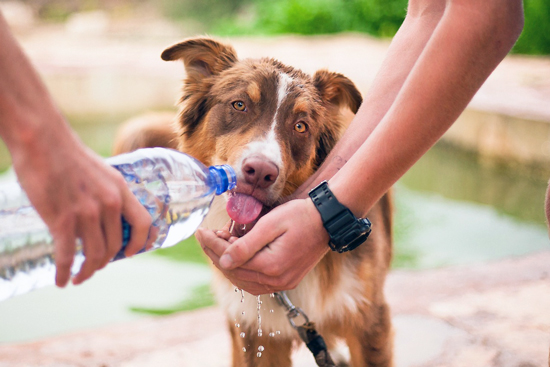

Why First Aid? | About Show-Me Animal Products | News | Home
Have Questions? Call 816-781-5154 (toll free, 1-800-831-7245) or e-mail: Showmeanimal@vsiserve.org
Return to News Index
Late Summer Pet Threats Bring Unique Challenges

Late season heat is one of the most widespead dangers facing pets even as fall comes close. Insect bites/stings, allergies and other threats are common as well.
Heat dangers like heat exhaustion and heatstroke can be serious issues even though fall is close. But temperatures may remain high, and pets can easily suffer. Danger signs include heavy panting, drooling, weakness, vomiting, and collapse. Provide plenty of shade, fresh water, and avoid strenuous activity during the hottest parts of the day. If your pet shows signs of heatstroke, move them to a cooler area, offer water, and seek veterinary help immediately.
Fleas, ticks, and other pests are often at the worst in late summer, including fleas, ticks, and other parasites. Regularly check your pet for ticks and use recommended preventive treatments. Keep your pet's living area clean and vacuumed to reduce the risk of infestation.
Although allergies vary regionally, many can be a big issue in late summer. Pollen allergies, a common example, may lead to skin itching, ear infections, or respiratory issues in pets. Consult your veterinarian for proper diagnosis and management.
Hot pavement and paw pad burns can be serious and even very warm payment can still endanger your pet and may be missed by pet owners wearing shoes. Test the pavement with your hand before walking your pet or consider using protective booties.
Lawn and garden chemicals: Many people use lawn and garden chemicals during the late summer. These can be toxic to pets if ingested or if pets come into contact with treated areas. Keep your pet away from recently treated areas and store chemicals securely.
Water-Related Hazards: Pools, lakes, and rivers can pose dangers for pets, especially if they're not strong swimmers. Always supervise your pet near water and consider getting them a life jacket if they'll be swimming. And remember a pet left in cold water too long can be in serious danger.
Late summer barbecues and picnics may lead to manyd pets ingesting foods that are harmful, such as onions, garlic, chocolate, grapes, and fatty foods. Keep these foods out of reach and be cautious about sharing human food with your pet.
If you're planning late summer trips or vacations, pet travel and changes in routine can cause stress for your pet. Plan for pet-friendly accommodations, ensure they have proper identification, and consider crate training for safe travel.
Insects are more active in late summer, and pets are susceptible to bee stings and insect bites. Don’t assume a previously safe area will always be free from danger. For example, yellow jacket colonies grow largest in late summer and early fall just when their food sources begin to diminish, providing plenty of frustrated, hungry wasps. If stung, monitor your pet for signs of allergic reactions and remove stingers if necessary.
Wildlife threats are similar. Late summer can bring more wildlife into suburban areas, potentially leading to encounters with unfamiliar animals. Ensure your pet's vaccinations are up-to-date and keep them on a leash during walks.
To address these problems, it's important to remain vigilant, provide appropriate preventive care with your first aid kit, and seek veterinary attention when necessary.




